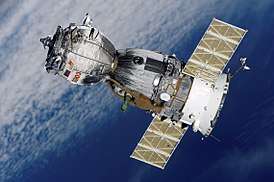Soyuz 7K-TM
The 1975 Apollo–Soyuz Test Project version of the Soyuz spacecraft (Soyuz 7K-TM) served as a technological bridge to the third generation Soyuz-T (T - транспортный, Transportnyi meaning transport) spacecraft (1976–1986).
_spacecraft.jpg) Soyuz 19, a Soyuz 7K-TM spacecraft, during the Apollo–Soyuz Test Project (ASTP). | |
| Manufacturer | OKB-1 |
|---|---|
| Country of origin | Soviet Union |
| Operator | Soviet space program |
| Applications | Manned spacecraft |
| Specifications | |
| Dimensions |
|
| Regime | Low Earth |
| Production | |
| Status | Retired |
| Launched | 5 |
| Retired | 5 |
| Maiden launch | Kosmos 638 3 April 1974 |
| Last launch | Soyuz 22 15 September 1976 |
| Last retirement | Soyuz 22 23 September 1976 |
| Related spacecraft | |
| Derived from | Soyuz 7K-T |
| Derivatives | Soyuz 7K-S Soyuz 7K-ST |
The Soyuz ASTP spacecraft was designed for use during the Apollo Soyuz Test Project as Soyuz 19. It featured design changes to increase compatibility with the American craft. The Soyuz ASTP featured new solar panels for increased mission length, an APAS-75 docking mechanism instead of the standard male mechanism and modifications to the environmental control system to lower the cabin pressure to 0.68 atmospheres (69 kPa) prior to docking with Apollo. The ASTP Soyuz backup craft flew as the Soyuz 22 mission, replacing the docking port with a camera.
Uncrewed Missions
- Cosmos 638
- Cosmos 672
Images
External links
| Wikimedia Commons has media related to Soyuz spacecraft. |
- Russia New Russian spaceship will be able to fly to Moon - space corp
- RSC Energia: Concept Of Russian Manned Space Navigation Development
- Mir Hardware Heritage
- David S.F. Portree, Mir Hardware Heritage, NASA RP-1357, 1995
- Mir Hardware Heritage (wikisource)
- Information on Soyuz spacecraft
- OMWorld's ASTP Docking Trainer Page
- NASA - Russian Soyuz TMA Spacecraft Details
- Space Adventures circum-lunar mission - details

_drawing.png)






